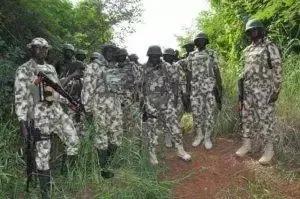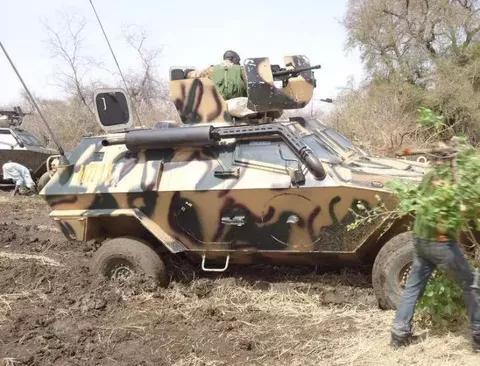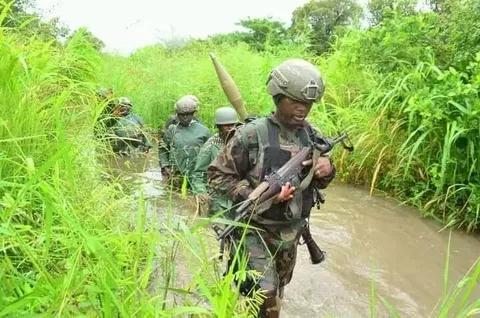History & Records
Welcome To The Jungle: See Interesting Photos Of Nigerian Soldiers In The Jungle (Photos)
In jungle warfare, the soldier often fights two enemies: man and nature. The elimination of nature as an enemy and the use of the jungle itself as an ally are training objectives fully as important as the elimination of the human enemy. The soldier must be trained not to fight the jungle; he must be capable of living successfully in it and making it work for him against the human enemy.

A typical example of a jungle warfare is the ongoing war between the Nigerian security forces and the dreaded Boko Haram insurgents in the Sambisa Forest. See photos below;




To some people in Maiduguri, the Sambisa is a forest game reserve located not far from the state capital. About 14 kilometres from Kawuri Village, along the Maiduguri–Bama Road, you will begin to see signs that you are close to the lowest thorny bushes of the reserve, some as low as half a metre.
It is not the typical forest one sees along some southern states which could be as high as 100m, creating a primary, secondary and tertiary scenario. It is a single dimensional forest which is visible driving through the main road that connects Maiduguri, Konduga and Bama.



Actually it also graduates from trees as low as half a metre to the extremely thick areas where human skins cannot penetrate without being hurt by thorns if you do not have a cutlass or something to ward them off. That is the nature of the forest which is being manipulated and controlled by Boko Haram who have become masters of the savannah.
The Nature Of The Sambisa Forest
1- Inaccessible Terrain
Insurgency in Nigeria is becoming persistent, with insurgents taking advantage of some of Nigeria’s most inaccessible terrain landscape such as the Lake Chad Basin to move around, bivouac and launch offensive campaigns.


These insurgents include Boko Haram (BH) terrorists, ISWAP, fulani herdsmen and armed bandits etc.
Below are some photos of the after effect of inaccessible terrain on soldiers:




Soldiers become sitting ducks for concealed snipers when their protective vehicles get stuck in mud loose earth.
2- Weather
In general, Sambisa forest weather is hot, humid, and characterized by sudden changes. Within only few minutes clear, hot weather may change to torrential downpour. With equal suddenness, the rain may cease and sunshine on the thickly matted vegetation will produce maximum relative humidity. Humidity is constantly high because of the swamps and the shading effect of vegetation.




There is “rainy season” during which monsoons and storms may prevail and rain is considerably more fre- quent. Seasonal changes in weather are noticeable but not pronounced. The humid heat of the day is often relieved by cool air from the mountains in the late evening.
3- Wild Life
Life, particularly plant and insect life, flourishes in this hot, damp environment. The danger from wild animals which roam the jungle is, however, largely creation of imagination.



Animals are fairly abundant in some places and rare in others, but even when abundant, are not commonly seen by man. Most animals have natural fear of man and their keen senses enable them to keep out of sight.


Proper identification of wild plants and animals is of further value to units or individuals cut off from supply lines and depending upon plants and animals for food. However, it is so difficult to come within range of jungle animals that it is best not to rely on hunting as means of obtaining food; edible fruits, nuts, and plants are more easily obtained.
May God continue to protect our soldiers.
Follow us on social media:-

 Celebrity Gossip & Gist1 day ago
Celebrity Gossip & Gist1 day ago“The money wey dem pay me don expire” – Moment Burna Boy stops his performance at the Oando PLC end of the year party (Video)
-

 Economy1 day ago
Economy1 day agoGoods worth millions of naira destroyed as fire guts spare parts market in Ibadan
-

 Celebrity Gossip & Gist10 hours ago
Celebrity Gossip & Gist10 hours agoMoment stage collapses on Odumodublvck during concert performance (Video)
-

 Economy10 hours ago
Economy10 hours agoPresident Tinubu cancels Lagos engagements in honor of food stampede victims




